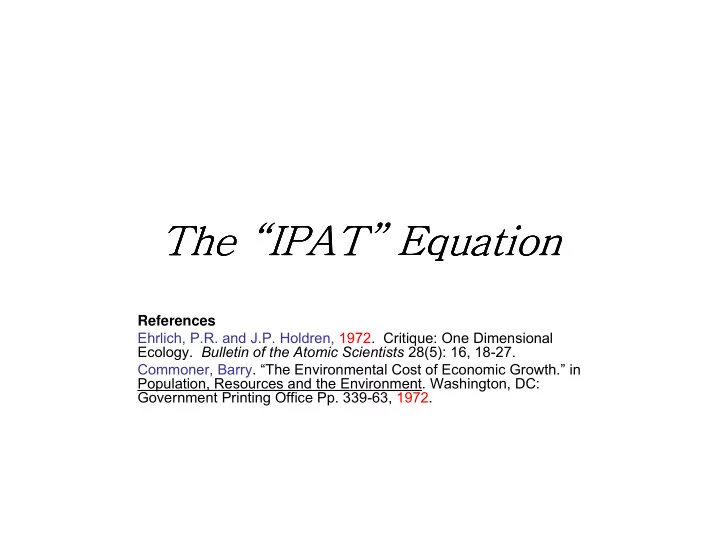

The “ IPAT ” Equation The “ IPAT ” Equation The “ IPAT ” Equation The “ IPAT ” Equation References Ehrlich, P.R. and J.P. Holdren, 1972. Critique: One Dimensional Ecology. Bulletin of the Atomic Scientists 28(5): 16, 18-27. Commoner, Barry. “The Environmental Cost of Economic Growth.” in Population, Resources and the Environment. Washington, DC: Government Printing Office Pp. 339-63, 1972.
Disaggregating the Problem Goods & Services Impact = × × Impact Population Person Goods & Services = × × I P A T The IPAT equation is a mathematical identity that shows that the underlying environmental problems are related to “scale”. Growth in Population and Affluence have exceeded improvements in Technology. Furthermore the terms in the equation are highly coupled!
for infinitesimals ∆ ∆ ∆ ∆ I P A T = + + I P A T Technology Population Growth Affluence = GWP per captia
Population Dynamics ∆ = − [ ] R birth death R IN R OUT P 0 + − [ ] immigratio n emigration dP ∆ ⋅ dP = R t = ∆ ⋅ = ∆ ⋅ P P o e R dt R P P dt in the discrete form… P = ( + 6.5 B 1 ) n P P i World o 3.2 B Currently i ≈ 1 % 1965 2006 t
We are adding 70-80 M people/yr Add one Germany or 2X Canada each year
Affluence and GDP, GWP • GDP = Gross Domestic Product • GWP = Gross World Product • GWP = market value of all goods and services produced for a year
GWP, i ≈ 5% for 2004, 2005 Over the last several decades the growth in GWP has been less, more like 3%
To improve, we want… ∆ ∆ ∆ ∆ I P A T = + + < 0 I P A T “ “ technology ” technology ” “ “ technology ” technology ” Based on 1 %+4%-5%=0 global estimates … We must improve our environmental performance on goods and services by 5% a year just to stay even.
“ “ “ “ IPAT “ examples IPAT “ examples IPAT “ examples IPAT “ examples 1. Automobiles and gasoline 2. pig iron and energy 3. global carbon
1 . Gasoline Used in Automobiles 1 . Gasoline Used in Automobiles 1 . Gasoline Used in Automobiles 1 . Gasoline Used in Automobiles What are the factors that influence the amount of gasoline we burn in automobiles? miles driven gasoline = × × gasoline number of cars car mile Impact population service provided technology car “I” “P” “T” “A”
2. 2. Energy used to make pig iron Energy used to make pig iron 2. 2. Energy used to make pig iron Energy used to make pig iron pig iron energy = × × Energy number of factories factory pig iron energy = × Energy pig iron produced pig iron Again the energy used per ton pig iron produced depends upon the technology used.
3. Carbon emissions 3. Carbon emissions 3. Carbon emissions 3. Carbon emissions GWP Energy Carbon = × × × Carbon Population Pop GWP Energy ∆ Carbon = + + − − = + 1% 2% 1.25% 0.25% 1.5% Carbon These are rough averages over the last 3 decades, data taken or calculated from Pacala & Socolow, Science 2004
Fertility and Affluence see www.Harvard.edu
Affluence and Energy are correlated Affluence and Energy are correlated Affluence and Energy are correlated Affluence and Energy are correlated From Smil
From a Production point of view Impact = × Impact Production Production Energy Used Production (P) or Consumption 1/efficiency (e) 1 = × I P e
Differentiating Differentiating Differentiating Differentiating 1 dI dP P de = − ≤ 0 2 dt e dt e dt Normalizing, and taking yearly increments, you are an environmentally benign producer when… ∆ ∆ e P ≥ e P The Gold Standard The Gold Standard The Gold Standard The Gold Standard
Note that “ e ” and “ P ” are coupled! Note that “ e ” and “ P ” are coupled! Note that “ e ” and “ P ” are coupled! Note that “ e ” and “ P ” are coupled! • e = f (P) e = f (P) e = f (P) e = f (P) Increased production Increased production leads to leads to Increased production Increased production leads to leads to increased efficiency through learning effects increased efficiency through learning effects increased efficiency through learning effects increased efficiency through learning effects and economies of scale and economies of scale and economies of scale and economies of scale • P = f (e) P = f (e) P = f (e) P = f (e) Increased efficiency can lead Increased efficiency can lead Increased efficiency can lead Increased efficiency can lead to reduced prices and increased demand. The to reduced prices and increased demand. The to reduced prices and increased demand. The to reduced prices and increased demand. The phenomenon is called the “ rebound effect ” phenomenon is called the “ rebound effect ” phenomenon is called the “ rebound effect ” phenomenon is called the “ rebound effect ”
Recommend
More recommend